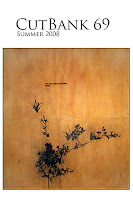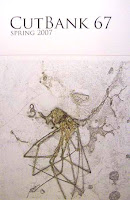

Letter Machine Editions, 2010
Chicago, Illinois
http://www.lettermachine.org/
ISBN: 0981522726
by Karen An-hwei Lee
The latest collection by translator and poet Sawako Nakayasu, Texture Notes, features 48 original journal entries dated from 2003 to 2004, arranged in a variety of textures and rhythms. With echoes of Zukofsky poetics and Steinian word-play, Nakayasu explores the poetic challenge of describing physical textures in the external world: bicycles, fresh laundry, love in the air. To this end, the kaleidoscopic prose fragments resist simplistic interpretations, playing with formal categories of definition in a choreography of word-objects reminiscent of the early Modern objectivist poets:
7.9.2003
Ant-sized objects, in the order received:
Ant, microchip, staple, pine needle, dimple, pebble, the ant’s twin, a one-to-one scale model of the ant, another ant of the same size, dust, crumb, fingernail, crumb, staple, mustard seed, the letter ‘I’ typed in 12-pt. font…. (19)
Focusing on “thingness” in the abstract and concrete senses, Texture Notes investigates the texture of bicycles in its first succinct prose poem, contemplates the textures of absence in an elegant one-line poem, 10.4.2003: “layers of loss” (7), and directs the reader’s attention to self-referential components in 11.8.2003: “Line trying to crumple its way into texture…” (17).
Nakayasu’s book-length collage is a recombinatory syncopation of astute observations: “Combined sum of the texture of one word at each moment everywhere, thicker than it is true” (11). With varying poetic densities at once macrocosmic and minutely liminal, the contradictions of urban life are depicted in miniature:
9.20.2003
Thirty thousand unanswered minutes, eight arms filled to capacity three times over, a four-year-old tree attaining twice its current height thanks to the tears of a widow, one small Chinese girl and a couple of kegs, five million rotations of this old fan, whichever comes last.
Or the rock that develops a dent, small stone in my hand.
Waiting for.
The rock to grow, spread, answer, spin, cold and smooth, after all the rain in my hand, or before it stops, or before it returns, quickly now -- (67)
At times, the poems take on the surreal allegorical qualities of a Russell Edson fable, as in 4.6.2004, whose first line begins: “Texture of a field of fried umbrellas” (9).
…Enough fresh oil was used in the frying of these umbrellas that theoretically the should repel any sort of fluid which takes a shot at the field, and in fact this is true, but the unfortunate inherent shape of umbrellas encourages the rain to slip inside the crevices between one fried umbrella and another, getting the toes of the children wet, whether they are there or not. (9)
Tinkering mischievously with a reader’s expectations, Nakayasu swiftly mingles the textures of word-objects as nouns by using language usually applied to other categories of definition. An emotion, for instance, is portrayed using meteorological language: “Love as described by the heaviness of air, measured by a repeated rise in humidity” (13).
According to the Etymology Dictionary, “texture” derives from the Latin textura for “web, texture, structure,” and from the stem of texere “to weave.” The word “text,” similarly, originates from the “wording of anything written” with its root in the Latin textus: “Scriptures, text, treatise,” also sharing a genesis from the stem of texere.
In perfect resonance with its etymological origins, Texture Notes weaves epistemological questions about categories of knowledge, or how we know what we know about the world, culminating in the phenomenon we call beauty.
8.22.2003 ….People, pilgrims, innocent bystanders, drivers-by, tourists, and locals alike come and gather, independently and in their own time, in their very own time, to admire it. And enjoy it. To provide a physical, chemical, psychoanalytical, or textural analysis of it. To assign it values of beauty.
---
Sawako Nakayasu was born in Japan and has lived mostly in the US since the age of six. Her most recent books are Texture Notes (Letter Machine, 2010), Hurry Home Honey (Burning Deck, 2009), and a translation of Kawata Ayane’s poetry, Time of Sky//Castles in the Air (Litmus Press, 2010). Her translation of Takashi Hiraide’s For the Fighting Spirit of the Walnut (New Directions, 2008) received the 2009 Best Translated Book Award from Three Percnt.
- - -
 Karen An-hwei Lee is the author of Ardor (Tupelo Press, 2008), In Medias Res (Sarabande Books, 2004), and a chapbook, God’s One Hundred Promises (Swan Scythe Press, 2002). Her books have been honored by the Norma Farber First Book Award from the Poetry Society of America (chosen by Cole Swensen) and the Kathryn A. Morton Prize for Poetry (selected by Heather McHugh). The recipient of a National Endowment for the Arts Grant, she chairs the English department at a faith-based college in southern California, where she is also a novice harpist.
Karen An-hwei Lee is the author of Ardor (Tupelo Press, 2008), In Medias Res (Sarabande Books, 2004), and a chapbook, God’s One Hundred Promises (Swan Scythe Press, 2002). Her books have been honored by the Norma Farber First Book Award from the Poetry Society of America (chosen by Cole Swensen) and the Kathryn A. Morton Prize for Poetry (selected by Heather McHugh). The recipient of a National Endowment for the Arts Grant, she chairs the English department at a faith-based college in southern California, where she is also a novice harpist.



